Response to the Historical Audit on Slavery
October 2019
Princeton Theological Seminary Board of Trustees unanimously endorsed the implementation of a multi-year action plan to repent for its ties to slavery. Learn more about Princeton Seminary's response to the historical audit on slavery
Truth Telling and Racial History
October 2018
During a panel presentation on the Princeton Seminary and Slavery Report* given at Princeton Theological Seminary on October 17, 2018, Curator of Special Collections and Archivist Kenneth W. Henke shared stories from the archives. Specific Princeton Seminary alumni named in the report include Theodore Sedgwick Wright, Class of 1828 and Elijah Parish Lovejoy, Class of 1834, among others.
Read the full report: Princeton Seminary and Slavery
November 7, 2017
Historical Tour of Princeton Theological Seminary
by Michael J. Paulus, Jr.
Revised 2012
Contents
- Princeton, the College of New Jersey, and the Revolution
- The Establishment of the Seminary at Princeton
- The Expansion of the Seminary in the Nineteenth Century
- The Evolution of the Seminary in the Twentieth Century and Beyond
1. Princeton, the College of New Jersey, and the Revolution
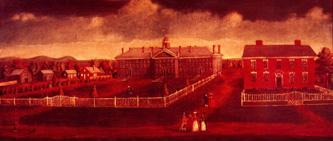
The earliest colonists to settle in the Princeton area arrived in the late 17th century. By 1724, the area was being referred to as Prince-Town, in honor of King William III, Prince of Orange.
In 1756, construction of Nassau Hall was completed and Princeton became the home of the College of New Jersey (now Princeton University). The College of New Jersey, the fourth chartered college in the colonies, was established in 1746 by a group of ministers and laymen who wanted a college that was supportive of the Great Awakening.
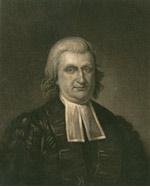
In 1768, John Witherspoon was called from Scotland to be the sixth president of the College of New Jersey. Under Witherspoon’s leadership, Princeton became one the most influential centers of American learning. Largely because of Witherspoon, the only clergyman and college president to sign the Declaration of Independence, Princeton became known as the “seedbed” of the American Revolution. Six months after the Declaration was signed, Princeton was the site of a strategic victory for George Washington, when he surprised the British in the Battle of Princeton and drove them from Nassau Hall.
2. The Establishment of the Seminary at Princeton
The period following the Revolution was one of great uncertainty. As the new republic began to establish a workable system of government, stabilize its economy, expand westward, and form its identity, church leaders began reevaluating the manner in which ministerial candidates were being educated. Ministers of the gospel, they hoped, would be instrumental in shaping the new nation. This would not happen unless they were well-trained.
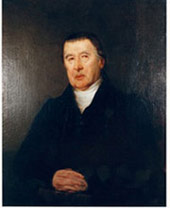
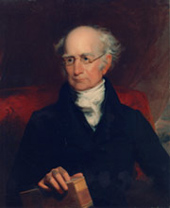
Throughout the eighteenth century, Protestant theological education was included as part of the undergraduate curriculum in colleges and universities. But as the national demand and need for pastors increased, colleges such as the College of New Jersey became less concerned with producing ministerial candidates and were not graduating enough of them.

In the early 1800's, two Presbyterian ministers, Ashbel Green from Philadelphia and Samuel Miller from New York City, began discussing the establishment of a Presbyterian school that would be dedicated solely to the education of ministers. Green and Miller were unhappy with the administration of the College of New Jersey, which would have been the logical place to locate their theological school, so they decided to establish a separate school. They also decided that the curriculum of this new school would supplement rather than replace a classical college education. This plan meant that Presbyterian ministers would be among the most educated in the country.
Two events in 1808 propelled forward the Presbyterian movement for a theological school. In 1805, a Unitarian had been appointed to the chair of divinity at Harvard. A group of New England Congregationalists responded to this event by opening in 1808 the first formal, post-graduate “theological seminary” at Andover, Massachusetts. That same year, at the 1808 General Assembly of the Presbyterian Church in the United States of America, Archibald Alexander, a pastor in Philadelphia and former president of Hampden-Sydney College, preached a sermon that called on the church to establish seminaries to ensure a regular and sufficient supply of qualified ministers.

In 1811, following a series of overtures and committee reports, a plan for a theological seminary was approved by the General Assembly. The guiding principle of the plan was to form a theological seminary that would be “a nursery of vital piety, as well as of sound theological learning.” The church did not only want educated ministers with “solid learning”; it needed transformed ministers who had experienced “the renewing and sanctifying grace of God.”
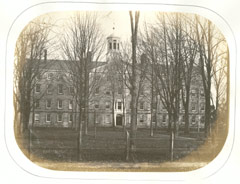
The General Assembly of 1812 elected a board of directors for the Seminary and Archibald Alexander as the Seminary’s first professor. After reaching an agreement with the trustees of the College of New Jersey that defined a cooperative rather than competitive relationship between the two schools, the General Assembly resolved to locate its new seminary in Princeton. In August, 1812, Alexander was inaugurated and began teaching the Seminary’s first three students in his temporary home in Princeton.
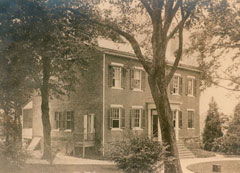
More students came to study at Princeton Seminary, and in 1813 Samuel Miller was appointed the Seminary’s second professor. By then, the Seminary was operating out of Nassau Hall and was ready for a building of its own. In 1815, the cornerstone was laid for the Seminary’s first building, Alexander Hall, which was in use by 1817. Initially referred to as Old Seminary, Alexander Hall had dormitory rooms for about 100 students; a refectory and kitchen; a large oratory, which was used for lectures, chapel services, and student meetings; and, by 1820, it accommodated the Seminary’s growing library.
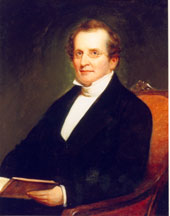
As work was concluding on Alexander Hall in 1819, the Seminary built a house next to it for Alexander. A house for the Seminary’s third professor, Charles Hodge, was completed in 1825 on the opposite side of Alexander Hall. Hodge graduated from the Seminary in 1819, joined the faculty as an instructor in 1820, and was appointed the Seminary’s third professor in 1822. The plan for the Seminary called for at least three professors, each specializing in a different area. With the addition of Hodge to the faculty, by its tenth anniversary the Seminary’s plan was fully implemented.
3. The Expansion of the Seminary in the Nineteenth Century
As the Seminary continued to grow, its activities quickly expanded beyond the spaces that had been provided for them in Alexander Hall. The first needs for additional space were directly related to the twin goals of the Seminary: piety and learning. By 1830, more space was needed for worship and for books and study. The Seminary began seeking funds first for a chapel, and in 1834 Miller Chapel, situated between Alexander House and Alexander Hall, was completed. (The Chapel was moved to its current position in 1933, at which time a chancel and basement were added.)
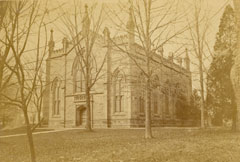
In 1843 James Lenox, a philanthropist and bibliophile from New York City, built for the Seminary one of the first free-standing academic library buildings in America, Lenox Library. Alexander described it as “a beautiful Gothic building, 80 feet by 50, of brown stone … The floors are of marble. The roof is slated. The whole, except the vestibule, is in one room, with a gallery. There are alcoves on two sides of the room.”
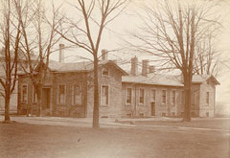
Another building was added to the Seminary campus in 1847. Located behind Alexander Hall, this building contained a kitchen, dining room, quarters for the cook, and a hospital room. The building was used later as a dormitory, then as a gymnasium, and in 1945 it was converted into office space and became the Administration Building.
By 1860, the Seminary had run out of boarding options for its students. Isabella Brown, a wealthy widow from Baltimore, had agreed to build a second dormitory. But when the Civil War broke out, Mrs. Brown, whose sympathies were with the South, declined to go forward with the plan. However, when Professor McGill, whom she knew, wrote to her and assured her that "Southern and Northern students were alike privileged and fostered here" and that some of the Southern students "had actually fought in the ranks of the Confederate soldiery" yet were able to walk "unmolested, and without reproach" in the streets and halls of Princeton, her disinclination was reversed, and Brown Hall became the only major building constructed in Princeton during the Civil War. It was completed in 1865.
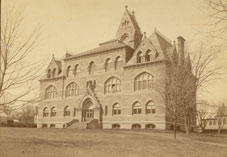
Although development of many larger theological seminaries was disrupted by the Civil War, Princeton Seminary continued to grow. More room was needed for classes, and in 1878 Stuart Hall opened to function as the Seminary’s primary lecture hall. The building bears the name of the brothers Robert and Alexander Stuart, wealthy sugar refiners from New York City, who donated funds for the building.
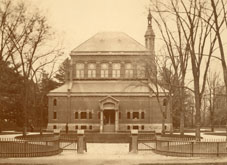
By this time more room was needed for books, and in 1879 the New Lenox Library, also built by James Lenox, opened behind the Lenox Library. This high Victorian brick building provided more space for study; the older library was used for rare and less frequently used books.
In time, additional housing facilities were needed. In 1893, with funds from a bequest of the widow of Robert Stuart, Hodge Hall was built as a third dormitory for the Seminary. The building was designed so that each room would receive sunlight at some point during the day.
4. The Evolution of the Seminary in the Twentieth Century and Beyond

By the beginning of the twentieth century, America and its institutions had matured. At its sesquicentennial in 1896, the College of New Jersey changed its name to Princeton University, signaling its intention to develop beyond a liberal arts college into a research university. The Seminary had grown into a school with 12 professors and about 150 regular and advanced students. To create a more efficient administration of the Seminary, Francis L. Patton, who had just retired from the presidency of Princeton University, was called as the Seminary’s first president. As a suitable home for its president, the Seminary purchased Springdale, which had been built around 1850. Patton, in an argument with Harvard president Charles Eliot in the 1880s over the nature of theological education, had argued that theological seminaries were not merely concerned with theological education and research but with ministerial education for the church. Whatever changes would occur in American academic culture, the Seminary’s first loyalty would be to the church.
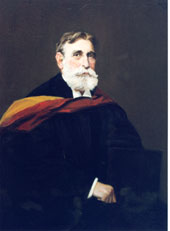
Charles Hodge’s most gifted student and successor, Benjamin B. Warfield, died in 1921. Warfield’s death marked the end of what has been called Old Princeton and the Princeton Theology, which was characterized by a biblical Calvinism, Reformed piety, and evidentialist apologetics. In 1929, after much internal turmoil, the governing structure of Seminary was reorganized and a group of dissatisfied professors and students, led by J. Gresham Machen, left to establish Westminster Theological Seminary.
During this tumultuous period at the Seminary, which reflected broader changes occurring in the Presbyterian Church and American culture, the Seminary campus remained largely unchanged. One notable exception was the construction of Payne Hall, which was built in 1922 with funds from the Payne family. The first student group organized at the Seminary was the Society of Inquiry on Missions, which was formed to cultivate student interest in missions. Payne Hall, representing the Seminary's support of global missions, provided housing for missionaries on furlough.
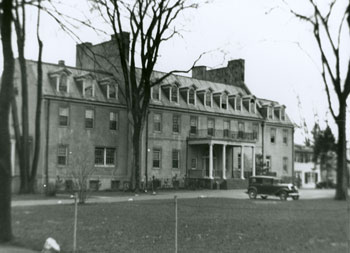
In 1936, Scotsman John A. Mackay became the Seminary’s third president. Under his leadership the Seminary began grow and change in many significant ways. The General Assembly of 1941 recommended that graduate schools of Christian Education be established for women at seminaries. The following year the Tennent College of Christian Education, which had opened in Philadelphia in 1907 to train women for lay leadership roles in the church, conveyed its assets to the Seminary in exchange for the Seminary’s pledge to carry on the work of the school at the graduate level.
To accommodate this expansion of its curriculum, the Seminary acquired in 1943 the campus of the Hun Preparatory School, now called the Tennent Campus, which included buildings for classrooms, dormitory rooms, and a gymnasium. Although a few women had matriculated at the Seminary earlier in the twentieth century, in 1944 women began to regularly attend the Seminary. (1944 was also the year in which the Seminary awarded its first doctorate degree, as part of a program that was begun in 1940.) Mackay’s next major project was the development of a Campus Center. The Mackay Campus Center opened in 1952 to replace Seminary eating clubs, which had supplanted the Seminary's apparently inadequate refectory. Mackay’s intention was to create a stronger sense of community at the Seminary by providing a common space where an increasingly diverse student body could meet and dine together.
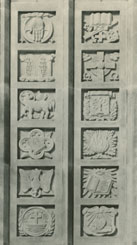
The two Lenox Libraries were razed to make room for the Robert E. Speer Library, which opened in 1957. Mackay named the building after his close friend Robert E. Speer, former Seminary trustee and General Secretary of the Presbyterian Church’s Board of Foreign Missions. When it opened, Speer Library was a model research facility. It provided ample space for library resources and services and contained a number of seminar rooms. Over the main entrance of Speer Library were two columns of seals symbolizing important Christian truths. The first image, at the top of the left column, is the creative hand of God, signifying the divine initiative; the last image, at the bottom of the right column, is John Calvin’s dedicated heart, signifying the human response to God.
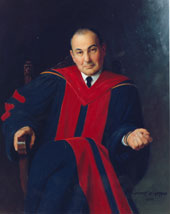
In 1959, James I. McCord became the Seminary’s fourth president. McCord was committed to the advancement of theological education and research. One outcome of this commitment was the establishment of the Center of Continuing Education. The first continuing education seminars were held in Adams House (named after Dean Arthur M. Adams), which was purchased by the Seminary in 1962. Erdman Hall, the former site of the home of Professor Charles Erdman, was built as a dormitory in 1981 and then renovated in 2000 to provide state-of-the art facilities for continuing education programs.
McCord also established the Center of Theological Inquiry, in 1978, to support advanced research in theology. The CTI was modeled on the Institute for Advanced Study, which was founded in Princeton in 1930 as the first residential research institute for scholars in United States. Luce Hall was built for the CTI in 1984.

As early as the 1950s, the Seminary had been seeking better accommodations for married students. In 1965, McCord purchased an apartment development on what is now the Seminary’s West Windsor Campus. In 1979, the Seminary received a $16 million bequest and the mortgage on the property was paid off. The apartments are now named after the philanthropist’s mother, Charlotte Rachel Wilson, and the philanthropist’s name was given to the adjacent Charlotte Newcombe Social and Study Center, which opened in 1982. Also located at the West Windsor Campus are the Seminary Pool (which opened in 1991), the Witherspoon Apartments (which opened in 1998), and the Dupree Center for Children (a child care center, which opened in 1995 at the CN Center).
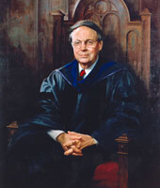
In 1983, Thomas Gillespie became the fifth president of the Seminary. Under his leadership, the Seminary continued to grow. Templeton Hall was completed in 1989 and contains administrative offices, preaching labs, and state-of-the-art media facilities. It is named after Sir John Templeton, who established the Templeton Fund and the Templeton Prize in Religion. Templeton became a trustee of the Seminary in 1951, and under his guidance the Seminary’s endowment grew substantially. The Henry Luce III Library, named after a former Seminary trustee and chairman of the Luce Foundation, opened in 1994 to further support research at the Seminary. Luce Library houses a repository for the archives of the Seminary and for manuscripts, rare books, and special research collections.

During his tenure, president Gillespie raised over $30 million for the renovation of older campus buildings. In 2000 Miller Chapel was renovated for the fourth time. Scheide Hall, a new building which opened in the same year, is named after a generous trustee emeritus of the Seminary, William H. Scheide. Scheide Hall houses the offices of the chapel staff and provides rehearsal space for the Seminary choirs.
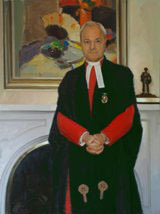
In 2004, Princeton Seminary called Iain Torrance, former Moderator of the General Assembly of the Church of Scotland and younger son of the noted Scottish theologian, Thomas F. Torrance, as its sixth President. Accomplishments during his administration included a thorough review of the Seminary's programs and expanded emphasis on the mission of the Seminary in the face of ongoing changes in global Christianity and interfaith relations. Major physical changes on the campus included a renovation of the Seminary Library and of the student housing in the Charlotte Rachel Wilson Complex.
For a brief narrative history of Princeton Seminary from its beginnings through 1992, see William K. Selden, Princeton Theological Seminary: A Narrative History, available in the Theological Commons.
The Archives of Princeton Theological Seminary
Learn more by consulting the archives of Princeton Theological Seminary in Special Collections.